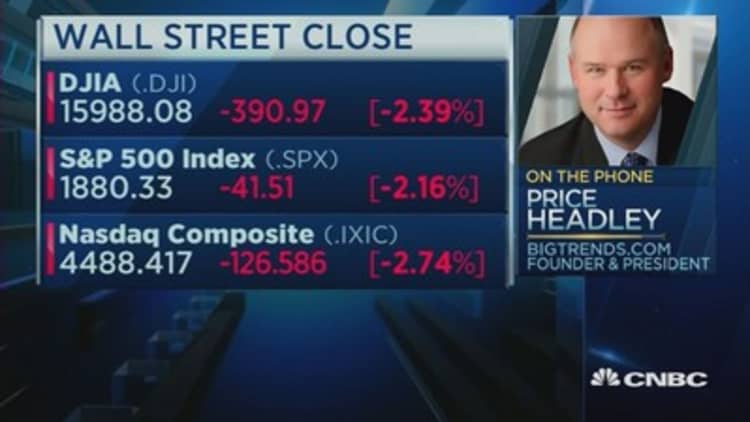To make the most of a market like the current one, smart long-term investors need strong stomachs and nerves of steel. The start of 2016 has brought with it a stomach-churning descent, with a promise of more of the same: The is down nearly 7 percent, the NASDAQ is down more than 9 percent, and after a five-year-plus bull market, many professional investors are set for further declines — or at least volatility.
The first rule, as always, is not to panic. The biggest mistake investors make in a decline is to sell in fear and then wait too long to get back in, missing the bounce up. Your worst mistake, based on history, would be to sell indiscriminately.
But your second-worst mistake would be to freeze up. Don't miss this opportunity to look ahead. Here are five moves to make now.
1. Consider saving more and taking more risk.
It may be painful, but investors need to adopt a realistic picture of what their returns in the public markets are likely to be over the next decade or two. Bottom line: Most people think equities are likely to return less, so if you want to meet your goals, you either need to save more or take more on risk.
Over the last 20 years, between 1985 and 2015, equity investors in the U.S. stock market saw an annual average return of nearly 10.9 percent. Bond investors saw an annual average return of 7.2 percent, based on the Barclays Aggregate Index.
But in investing, history doesn't predict the past. Roger A. Aliaga-Diaz, a principal economist with the Malvern, Pennsylvania-based Vanguard Group, said a more realistic expectation is 6 percent to 8 percent for equities over the next couple of decades, and 4 percent to 6 percent for a balanced portfolio of stocks and bonds. "It's a very different environment," he said. "On the fixed-income side, it's going to be very difficult to get returns of more than 2 percent to 3 percent."
Most assets are priced in relation to assets considered "risk free": U.S. Treasuries. With the yield on 10-year Treasuries at only about 2 percent, compared with 5 percent historically, investors have a low base to build on.
Burt Malkiel, Princeton economist, author of the classic Random Walk Down Wall Street and the chief investment officer of online financial advisor Wealthfront, pointed to the CAPE, the cyclically adjusted price-to-earnings ratio, which is about 40 percent correlated to future equities returns, he said. "The fact that it's relatively elevated suggests that the historical 9- or 10-year rate of return is unlikely to be realized," he said.
2. Look at your account.
Many people don't open the envelopes or look into their investment accounts in a down cycle. That's a mistake, because you could be missing opportunities to shift assets around to better suit your own risk tolerance and meet your goals. If you freak out when you look inside the envelope and stay scared, chances are good you have too much in equities. Dial back. If you look inside and find you can look toward the future, maybe you have the scope to take on more risk.
But the first step is to get a realistic picture of how your portfolio is performing in a down market. "What you're hearing in the headlines is not what is happening in your account," said Judith Ward, senior financial planner at Baltimore-based T. Rowe Price.

3. Rebalance, invest regularly and harvest losses.
Rebalancing back to your original vision for your portfolio forces you to buy low and sell high. If some of the asset classes in your account, like bonds or REITS, are performing better than equities, now may be the time to sell them and buy relatively lower-priced equity mutual funds, ETFs or stocks.
Investing small sums regularly over time increases returns in a volatile market, Malkiel said. His analysis of dollar cost averaging during the last decade, 2000–2010, showed that someone who invested regularly versus putting in a lump sum at the beginning of the decade had a return 1 percent higher for each dollar invested.
Tax-loss harvesting replaces an investment that has lost value with one that is similar, so that you keep your portfolio the same — but generates a loss that you can write off on your taxes. Investment advisors often offer tax-loss harvesting to their wealthier clients, and online investment services Wealthfront and Betterment offer daily harvesting to all the investors on their platforms. How much tax-loss harvesting is worth to you depends on your tax rate.
4. Diversify globally.
Emerging markets stocks are getting hammered by China's slowdown, and many experts think Americans are underexposed to international stocks for the long term. That's a recipe for bargains, if you have the stomach to shift your asset allocation to one that is somewhat more volatile.
"There's a growing consumer sector throughout the developing world," said Malkiel. "I think most people have basically no exposure to that. And I think that's a mistake."
Aliaga-Diaz agreed, pointing out that if you look at the total market capitalization of the world, the U.S. accounts for 52.6 percent, other developed economies are 37.8 percent, and emerging markets are 9.7 percent. If one of your goals is to match the market, you might need to increase your international allocation.
Vanguard begins with a recommendation for typical investors of, on the equity side, 40 percent international and 60 percent U.S., and on the bond side, 30 percent international and 70 percent U.S.
5. Go for long-term bonds.
You can use a similar time-based rationale for investing in long-term bonds. Longer-term bonds have higher yields but higher risks, because markets bet that it gets harder to predict the future the longer out you go, said Aliaga-Diaz. Another benefit is that they will provide ballast for equities in your portfolio. Overall, in a lower-return environment, the way to increase returns is to "take more risk," he said.
"The important thing is to be aware of the risk you're taking," he added. "There are no easy answers. There is no free lunch."






